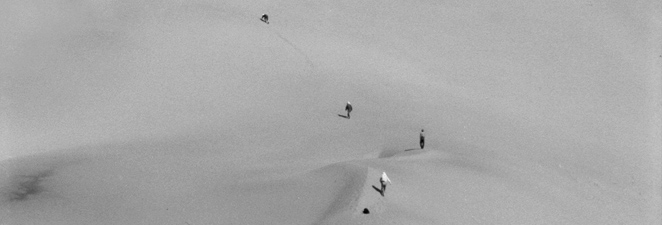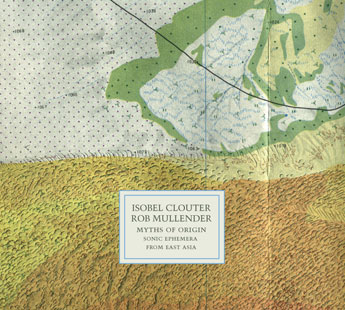Artist: Isobel Clouter & Rob Mullender
Title: Myths Of Origin - Sonic Ephemera From East Asia
Catalog Number: and/32
Release Year: 2008
Format: CD+
Status: available
Track List:
01. Sawara Matsuri / Singing Sand / Suikinkutsu
02. KotohiKi-hama - Kotoga-hama Beaches
03. Chion-in Temple / Nightingale Floor / Saiho-ji Temple
04. Dune Ascent / Descent
05. Aosigetunoer Descent
06. Baoritaolegainuoer Natural Booming
07. Baoritaolegainuoer Descent
08. Dune 3 Descent
09. Tibetan Prayer Wheels, Xiahe
Note: On June 9th, 2021, field recordings of booming sand phenomena from "Myths Of Origin" were featured in an Atlas Obscura podcast: https://www.atlasobscura.com/articles/podcast-booming-dunes
--------------------------------------------------------
At long last, after a culmination of delays amounting to 3 years, and/OAR is
extremely happy to finally present a full length release featuring "singing
sand" and "booming sand" recorded in Japan and Mongolia by British sound
artists Isobel Clouter and Rob Mullender. "Singing sand", "booming sand",
"whistling sand" or "barking sand" is sand that produces sounds of either
high or low frequency under pressure. The sound emission is usually
triggered by wind passing over dunes or by walking on the sand.
Also featured are field recordings of a traditional Japanese Sawara Matsuri
festival, a Suikinkutsu (underground water zither), Uguisubari (or Nightingale
floor), Chion-in temple and Saiho-ji temple .
The recordings came about as a result of a project instigated in late 1999,
which bears witness to a long held fascination with how the environment
generates and shapes culture, memory and myth. There was no desire to
conduct any scientific or anthropological field work, but to collect a set of
recordings which would serve to illustrate how precious the sonic
environment can be, and to act as founding materials for a soundscape
collection at the British Library Sound Archive.
The audio CD also features a PDF of extra photos pertaining to the
recordings that can be accessed on a computer, and comes packaged in a
four color digipak and a 12 page booklet.
This CD is dedicated to the memory of Professor Shigeo Miwa, whose warm
generosity and enthusiasm was invaluable to the success of this recording
project, and whose work is mentioned in an interesting article about
booming sand and the environment, a PDF of which can be found here .
Read the and/OAR interview of Isobel Clouter and Rob Mullender.
Reviews
___________________________________________________________________________________
Brain Dead Eternity (September 2009)
Environment-based editions are a dime a dozen these days, trying to
discover a special item a pretty hard assignment. Fear not, though: just walk
towards Dale Lloyd’s ever-impressive and/OAR to come across a catalogue
as diverse as the various facets of human activity, not to mention the level of
touching intensity shown by some of this label’s records over the years. This
splendid work by Clouter and Mullender was originally conceived in 1999,
year in which they decided to gather sounds that “would serve to illustrate
how precious the sonic environment can be, and to act as founding
materials for a soundscape collection at the British Library Sound Archive”.
All the pieces of this CD borrow from original recordings made in 2001 in
regions of Japan and China.
The sources of these impressions are traces of urban life and organic
reverberations perceived in different settings including temples, private
gardens, deserts and beaches. The team-mates appear to be principally
interested – as confirmed by the extremely detailed notes of the
accompanying booklet – in the phenomenon of booming sands, which they
frantically tried to capture in several occasions, mainly during a stay in the
Mongolian desert. Indeed the sounds recorded amidst the dunes
characterize the vast majority of the second half of the program - the one
where a distinctly droning nature, which renders the acoustic landscape
ominous at times, seems to prevail as opposed to the more variegated
expressions – sea waves, children at play amidst talking folks, metallic
thuds, kitchen-related noises, squeaking objects, traffic and other assorted
symptoms – that are mostly found in the Japanese files, but also in the
conclusive episode taped at the Labrang monastery in Xiahe, largely
characterized by the creaking spinning of Tibetan prayer wheels.
Leaving details aside, what actually strikes is the way in which Clouter and
Mullender managed to seize and subsequently organize the inherent
musicality of these flashes. It’s right here that contenders get separated from
pretenders in this particular area. One thing is sticking a microphone outside
a window and finding an excuse to release whatever happens in those sixty
minutes; another is embarking in a project of such extent and significance, a
trip that is not strictly geographic but touches the essential aspects of the
reactions that humans have when confronted with aural occurrences that do
not belong to a daily familiarity. Those responses are fundamental in
determining who we really are, as the behaviour in front of sound is the
perfect gauge for a soul’s depth and, at large, the real value of hypothetically
“sentient” entities. The amazement of the two partners, clearly expressed at
the end of “Dune 3” after having heard marvellous murmurs, is an indicator
in that sense. It shows the degree of love for existence that is necessary to
individuate a quintessence, something that was achieved completely in this
case, unpronounced mysticism and earthly manifestations blending in
physical radiance. (Massimo Ricci)
The Wire (May 2009)
Sand dunes can be said to 'sing' when, disturbed into movement by a
combination of a prevailing wind and certain levels of humidity, they emit
sound frequencies. There are only a small number of places in the world
where the acoustic phenomenon of singing sand has been documented.
Myths Of Origin results from a trip by UK field recordists Rob Mullender and
Isobel Clouter to regions of China and Japan to try to capture this elusive
occurrence.
They managed to record a natural incidence of it in an inner Mongolian
desert, which is no small achievement, along with a handful of other
artificially induced incidences (dunes can apparently be agitated into singing
by sliding down them). The sound itself is wonderfully rich, a dense
humming frequency, shuddering with multiple levels of sonic detail.
The recordings of the singing sand are interspersed with excerpts of rather
less elemental experiences, in monasteries, temples and gardens. Those
recorded in China somewhat tenuously attempt to trace the influence of
booming sand on the vocal traditions of the areas in question, and the tracks
recorded in Japan are "akin to sonic postcards", as Clouter and Mullender
themselves admit.
These tracks certainly divert attention towards the recordings of booming
sand, but there's a clear disconnect between the two, which is symptomatic
of the fact that Myths Of Origin wants to be a soundscape documentary and
an anthropological thesis, but can't manage both. But this flaw isn't fatal
however, and is outweighed by the album's value as a document of a rarely
encountered natural phenomenon. (Nick Cain)
Just Outside (February 2009)
When Dale from and/OAR wrote that he'd like to send me a couple of things, I
asked about this disc since I'd been intrigued by Richard's mention of it
recently. I'm pretty sure I'd never actually heard "singing sands" and maybe
had only vaguely known about their existence period. Dale kindly obliged.
The disc is a set of field recordings, the first three from Japan, the last six
from China. The non-sand dune recordings don't do so much for me --I'm not
sure to what degree they've been restructured but, aside from the
attractiveness of the sounds themselves (which is fine) I don't pick up that
extra dimension I've found in Tsunoda or, more recently, French. The dune
experiences, however, are pretty amazing, even as you understand you're
getting probably a hundredth the effect you would were you out in the field.
Essentially, cascading waves of sand on these large dunes can set into
action enormous resonance effects within the dune itself, sounding like the
Earth is deeply thrumming. Even as is, you might not want to play this with
your speakers too close to the shelf edge. Fascinating phenomenon.
(Brian Olewnick)
The Watchful Ear (February 2009)
I picked up this disc because of its inclusion of several recordings of shifting
sands, the incredible aural phenomena whereby large banks of sand that
have been set moving by gravity create a deep humming noise. These
sounds have been very rarely captured over the years, and the recordings
here are no doubt not even close to a good replacement for hearing them live
as here they are divorced from the magnificent natural power that creates
them. Still the recordings are good and are just one part of this album which
works as an audio diary for several trips to China, Japan and Mongolia. So
we don’t just hear the singing sands, but the wash of nearby tides, the
buzzing of passing flies and the sound of the two recordists as they make
their way to assorted vantage points. At the end of one track, after the
booming sounds of the sands have passed the pair are left discussing the
event in somewhat awestruck terminology, a charming moment. Like other
and/OAR releases have done in the past, the disc also contains PDF files of
photos taken to go with the music which is a thoughtful additional touch. I
found this release to be an interesting and pleasant listen, answering my
curiosity about how these sands might sound [they really sound nothing like
you might expect by the way]. (Richard Pinnell)
Aquarius Records (January 2009)
File this one right next to your Alan Lamb discs of singing telegraph wires
and the Broken Hearted Dragonflies album on Sublime Frequencies, as the
British sound art duo of Isobel Clouter and Rob Mullender have presented us
with some seemingly implausible recordings of 'booming sand'. These are
monotone frequencies generated by an avalanche of a sand dune under just
the right environmental conditions. Such sounds have been reported in
numerous times and places with Marco Polo recounting them on his
excursions to China, and with Charles Darwin finding similar sounds in the
deserts of Chile! At the onset of one of their recordings, we hear Isobel
huffing and puffing up to the top of a massive sand dune, before she puts her
ears to the ground (quite literally) in order to locate the origin of the rumbling
drone. Such a bracketing episode of human presence is very useful to frame
the stillness of the desert even as the booming sound resonates through the
landscape. It also helps to distance these natural sounds from their
manmade doomscape kin of a lowslung bass slumped in subharmonic
stupor against a rumbling amplifier. Aside from these impressively heavy
recordings, Clouter and Mullender offer some additional recordings from
elsewhere in Asia: hissing textures from windswept sand comingling with
cicadas buzzing in the summer sun, and a Tibetan prayer wheel revolving
through its wooden cycles of creaks and moans. These are good extracts of
pure phonography, but pale next to the thoroughly impressive booming sand
phenomenon.



